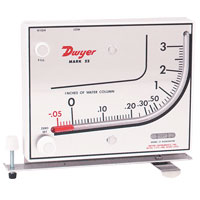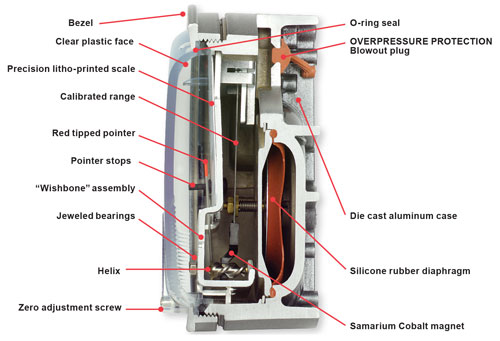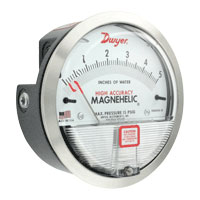
pressure with a liquid filled manometer. The manometer worked on the principle that the difference in air pressure is measured as a function of gravity and liquid density. The challenge, however, was that the liquid in the manometer evaporates over time. This means that individuals would need to regularly add more liquid and re-calibrate the device.
In 1953, J. Dwyer invented the Magnehelic® Differential Pressure Gage, a diaphragm based solution where differential pressure is applied to either side of the silicone diaphragm. The displacement of the diaphragm moves the magnet, which in turn moves the helix. The helix moves the indicating pointer on the scale. There are no mechanical linkages between the magnet and the helix; the minor variation in pressure is measured, translated and displayed in the simplest, most accurate way possible.

Does this mean that finding an elegant solution to an industry-wide problem is the key to making a market leading product?
The Magnehelic® Gage solved a technical problem in relation to pressure measurement. However, in the world of low pressure measurement, no two application uses are ever the same. From an air handling unit operator to a pharmaceutical clean room scientist, each and every customer is different. Just as each individual is different, the Magnehelic® Gage is installed and used differently as well.
The Magnehelic® Gage is a versatile option because of a variety of complimentary products and solutions which allow the device to be adapted to a large number of applications. For instance, it can be flush mounted on a panel or mounted on a wall. Additionally, if it fits the application needs, the Magnehelic® Gage can even be ordered to be installed at an angle.
Do you require a silicone-free diaphragm for your paint booth application, or a diaphragm made of Buna-N for a natural gas application for a oil and gas plant? The Magnehelic® Gage offers those choices.
The Magnehelic® Gage is such a trusted, versatile product that it has been used in quarantine facilities used by the NASA astronauts returning from the Apollo 11 mission.


A relatively new product offering to the line is the High Accuracy Magnehelic® Low Differential Pressure Gage. You may be wondering why would you use this instrument?
One element that separates market leaders from everyone else is that market leaders differentiate. They offer that “little bit more” for that customer who wants something extra.
Aimed at industries such as the pharmaceutical and packaging markets, the High Accuracy Magnehelic® Gage is now twice as accurate as the standard Magnehelic® Gage and has an accuracy within 1% for most ranges.
The well-engineered High Accuracy Magnehelic® Gage offers a mirrored overlay as standard, in order to eliminate any parallax error when taking measurements. A six-point calibration certificate is included with each high accuracy model. An optional, new, redesigned brushed SS bezel can also be ordered for additional corrosion resistance and a clean tapered design.
Legend has it, the inventor of the Magnehelic® Gage, J. Dwyer, threw the first Magnehelic® down a flight of stairs to check for it reliability.
At the time, he solved a problem with his new and reliable invention. It is because of this ingenuity that the Magnehelic® Differential Pressure Gage has become the market leader that it is today.
Source: The Project Apollo Image Gallery. (n.d.). Retrieved February 08, 2017, from http://www.apolloarchive.com/apollo_gallery.html

